A Dual-Gas Sensor Using Photoacoustic Spectroscopy Based on a Single Acoustic Resonator
Abstract
:1. Introduction
2. Materials and Methods
2.1. Measurement Principle
2.2. System Setup
2.3. Selection of Absorption Lines
3. Results
3.1. Calibration of CH4 and NH3
3.2. Simultaneous Measurement of CH4 and NH3
3.3. Instrument Performance: Allan Deviation, Accuracy, Precision and Uncertainty
4. Conclusions
Author Contributions
Funding
Institutional Review Board Statement
Informed Consent Statement
Data Availability Statement
Acknowledgments
Conflicts of Interest
References
- Cao, Y.; Sanchez, N.P.; Jiang, W.; Griffin, R.J.; Xie, F.; Hughes, L.C.; Zah, C.-E.; Tittel, F.K. Simultaneous atmospheric nitrous oxide, methane and water vapor detection with a single continuous wave quantum cascade laser. Opt. Express 2015, 23, 2121–2132. [Google Scholar] [CrossRef] [PubMed] [Green Version]
- He, S.; Xu, Z.; Jiang, Y.; Ji, J.; Forsberg, E.; Li, Y. Classification, identification and growth stage estimation of microalgae based on transmission hyperspectral microscopic imaging and machine learning. Opt. Express 2020, 28, 30686–30700. [Google Scholar] [CrossRef]
- Chen, K.; Liu, S.; Zhang, B.; Gong, Z.; Chen, Y.; Zhang, M.; Deng, H.; Guo, M.; Ma, F.; Zhu, F.; et al. Highly sensitive photoacoustic multi-gas analyzer combined with mid-infrared broadband source and near-infrared laser. Opt. Lasers Eng. 2020, 124, 105844. [Google Scholar] [CrossRef]
- Hanf, S.; Keiner, R.; Yan, D.; Popp, J.; Frosch, T. Fiber-enhanced raman multigas spectroscopy: A versatile tool for environmental gas sensing and breath analysis. Anal. Chem. 2014, 86, 5278–5285. [Google Scholar] [CrossRef] [PubMed]
- Xu, Z.; Jiang, Y.; He, S. Multi-mode microscopic hyperspectral imager for the sensing of biological samples. Appl. Sci. 2020, 10, 4876. [Google Scholar] [CrossRef]
- Selvaraj, R.; Vasa, N.J.; Nagendra, S.M.S.; Sm, S.N. Off-resonance photoacoustic spectroscopy technique for multi-gas sensing in biogas plants. Anal. Chem. 2019, 91, 14239–14246. [Google Scholar] [CrossRef]
- Besson, J.-P.; Schilt, S.; Thévenaz, L. Sub-ppm multi-gas photoacoustic sensor. Spectrochim. Acta Part A Mol. Biomol. Spectrosc. 2006, 63, 899–904. [Google Scholar] [CrossRef] [Green Version]
- Wang, G.; Kulinski, P.; Hubert, P.; Deguine, A.; Petitprez, D.; Crumeyrolle, S.; Fertein, E.; Deboudt, K.; Flament, P.; Sigrist, M.W.; et al. Filter-free light absorption measurement of volcanic ashes and ambient particulate matter using multi-wavelength photoacoustic spectroscopy. Prog. Electromagn. Res. 2019, 166, 59–74. [Google Scholar] [CrossRef] [Green Version]
- Dong, L.; Tittel, F.K.; Li, C.; Sanchez, N.P.; Wu, H.; Zheng, C.; Yu, Y.; Sampaolo, A.; Griffin, R.J. Compact TDLAS based sensor design using interband cascade lasers for mid-IR trace gas sensing. Opt. Express 2016, 24, A528–A535. [Google Scholar] [CrossRef]
- Köhring, M.; Huang, S.; Jahjah, M.; Jiang, W.; Ren, W.; Willer, U.; Caneba, C.; Yang, L.; Nagrath, D.; Schade, W.; et al. QCL-based TDLAS sensor for detection of NO toward emission measurements from ovarian cancer cells. Appl. Phys. A 2014, 117, 445–451. [Google Scholar] [CrossRef]
- Zhang, T.; Lou, X.; Xu, L.; He, S. Elemental mercury sensing by synchronously sweeping two multimode diode lasers. Appl. Opt. 2020, 59, 3360–3368. [Google Scholar] [CrossRef]
- Lin, H.; Lou, X.; Zhong, W.; He, S. Continuous monitoring of elemental mercury employing low-cost multimode diode lasers. Meas. Sci. Technol. 2015, 26, 085501. [Google Scholar] [CrossRef]
- Lin, H.; Gao, F.; Ding, Y.; Yan, C.; He, S. Methane detection using scattering material as the gas cell. Appl. Opt. 2016, 55, 8030. [Google Scholar] [CrossRef] [PubMed]
- Yao, X.; Li, S.; He, S. Dual-mode hyperspectral bio-imager with a conjugated camera for quick object-selection and focusing. Prog. Electromagn. Res. 2020, 168, 133–143. [Google Scholar] [CrossRef]
- Barbero, A.; Blouzon, C.; Savarino, J.; Caillon, N.; Dommergue, A.; Grilli, R. A compact incoherent broadband cavity-enhanced absorption spectrometer for trace detection of nitrogen oxides, iodine oxide and glyoxal at levels below parts per billion for field applications. Atmos. Meas. Tech. 2020, 13, 4317–4331. [Google Scholar] [CrossRef]
- Wu, T.; Zha, Q.; Chen, W.; Xu, Z.; Wang, T.; He, X. Development and deployment of a cavity enhanced UV-LED spectrometer for measurements of atmospheric HONO and NO2 in Hong Kong. Atmos. Environ. 2014, 95, 544–551. [Google Scholar] [CrossRef]
- Bayrakli, I. Tunable double-mode sensor for multi-gas detection based on the external-cavity diode laser. Appl. Opt. 2018, 57, 4039–4042. [Google Scholar] [CrossRef]
- Ye, W.; Li, C.; Zheng, C.; Sanchez, N.P.; Gluszek, A.K.; Hudzikowski, A.J.; Dong, L.; Griffin, R.J.; Tittel, F.K. Mid-infrared dual-gas sensor for simultaneous detection of methane and ethane using a single continuous-wave interband cascade laser. Opt. Express 2016, 24, 16973–16985. [Google Scholar] [CrossRef] [PubMed]
- Yu, Y.; Sanchez, N.P.; Griffin, R.J.; Tittel, F.K. CW EC-QCL-based sensor for simultaneous detection of H2O, HDO, N2O and CH4 using multi-pass absorption spectroscopy. Opt. Express 2016, 24, 10391–10401. [Google Scholar] [CrossRef] [PubMed] [Green Version]
- Jiang, J.; Wang, Z.; Han, X.; Zhang, C.; Ma, G.; Li, C.; Luo, Y. Multi-gas detection in power transformer oil based on tunable diode laser absorption spectrum. IEEE Trans. Dielectr. Electr. Insul. 2019, 26, 153–161. [Google Scholar] [CrossRef]
- Wu, H.; Yin, X.; Dong, L.; Pei, K.; Sampaolo, A.; Patimisco, P.; Zheng, H.; Ma, W.; Zhang, L.; Yin, W.; et al. Simultaneous dual-gas QEPAS detection based on a fundamental and overtone combined vibration of quartz tuning fork. Appl. Phys. Lett. 2017, 110, 121104. [Google Scholar] [CrossRef] [Green Version]
- Ma, H.; Sun, M.; Zhan, S.; Zhang, Q.; Zha, S.; Wang, G.; Liu, K.; Yi, M.; Cao, Z. Compact dual-gas sensor for simultaneous measurement of atmospheric methane, and water vapor using a 3.38 μm antimonide-distributed feedback laser diode. Spectrochim. Acta Part A Mol. Biomol. Spectrosc. 2020, 226, 117605. [Google Scholar] [CrossRef] [PubMed]
- Zheng, H.; Lin, H.; Dong, L.; Huang, Z.; Gu, X.; Tang, J.; Dong, L.; Zhu, W.; Yu, J.; Chen, Z. Quartz-enhanced photothermal-acoustic spectroscopy for trace gas analysis. Appl. Sci. 2019, 9, 4021. [Google Scholar] [CrossRef] [Green Version]
- Li, J.; Yu, B.; Zhao, W.; Chen, W. A review of signal enhancement and noise reduction techniques for tunable diode laser absorption spectroscopy. Appl. Spectrosc. Rev. 2014, 49, 666–691. [Google Scholar] [CrossRef]
- Besson, J.-P.; Schilt, S.; Thévenaz, L. Multi-gas sensing based on photoacoustic spectroscopy using tunable laser diodes. Spectrochim. Acta Part A Mol. Biomol. Spectrosc. 2004, 60, 3449–3456. [Google Scholar] [CrossRef]
- Choi, H.; Yeom, J.-Y.; Ryu, J.-M. Development of a multiwavelength visible-range-supported opto–ultrasound instrument using a light-emitting diode and ultrasound transducer. Sensors 2018, 18, 3324. [Google Scholar] [CrossRef] [PubMed] [Green Version]
- Pitre, L.; Sparasci, F.; Truong, D.; Guillou, A.; Risegari, L.; Himbert, M.E. Measurement of the boltzmann constant kB using a quasi-spherical acoustic resonator. Int. J. Thermophys. 2011, 32, 1825–1886. [Google Scholar] [CrossRef] [Green Version]
- Koskinen, V.; Fonsen, J.; Roth, K.; Kauppinen, J. Progress in cantilever enhanced photoacoustic spectroscopy. Vib. Spectrosc. 2008, 48, 16–21. [Google Scholar] [CrossRef]
- Schilt, S.; Tevenaz, L. Wavelength Modulation Photoacoustic Spectroscopy: Theoretical Description and Experimental Results. Infrared Phys. Technol. 2006, 48, 154–162. [Google Scholar] [CrossRef]
- Wang, Z.L.; Tian, C.W.; Liu, Q.; Chang, J.; Zhang, Q.D.; Zhu, C.G. Wavelength Modulation Technique-Based Photoacoustic Spectroscopy for Multipoint Gas Sensing. Appl. Opt. 2018, 57, 2909–2914. [Google Scholar] [CrossRef]
- Yin, X.K.; Dong, L.; Wu, H.P.; Zheng, H.D.; Ma, W.G.; Zhang, L.; Yin, W.B.; Jia, S.T. Sub-Ppb Nitrogen Dioxide Detection with a Large Linear Dynamic Range by Use of a Differential Photoacoustic Cell and a 3.5 W Blue Multimode Diode Laser. Sens. Actuator B Chem. 2017, 247, 329–335. [Google Scholar] [CrossRef] [Green Version]
- Pan, Y.; Dong, L.; Yin, X.; Wu, H. Compact and highly sensitive NO2 photoacoustic sensor for environmental monitoring. Molecules 2020, 25, 1201. [Google Scholar] [CrossRef] [PubMed] [Green Version]
- Gordon, I.E.; Rothman, L.S.; Hill, C.; Kochanov, R.V.; Tan, Y.; Bernath, P.F.; Birk, M.; Boudon, V.; Campargue, A.; Chance, K.V.; et al. The Hitran2016 Molecular Spectroscopic Database. J. Quant. Spectrosc. Radiat. Transf. 2017, 203, 3–69. [Google Scholar] [CrossRef]
- He, S.; Liu, K. On the possibility of a perfect power combiner. Prog. Electromagn. Res. 2017, 158, 1–6. [Google Scholar] [CrossRef] [Green Version]
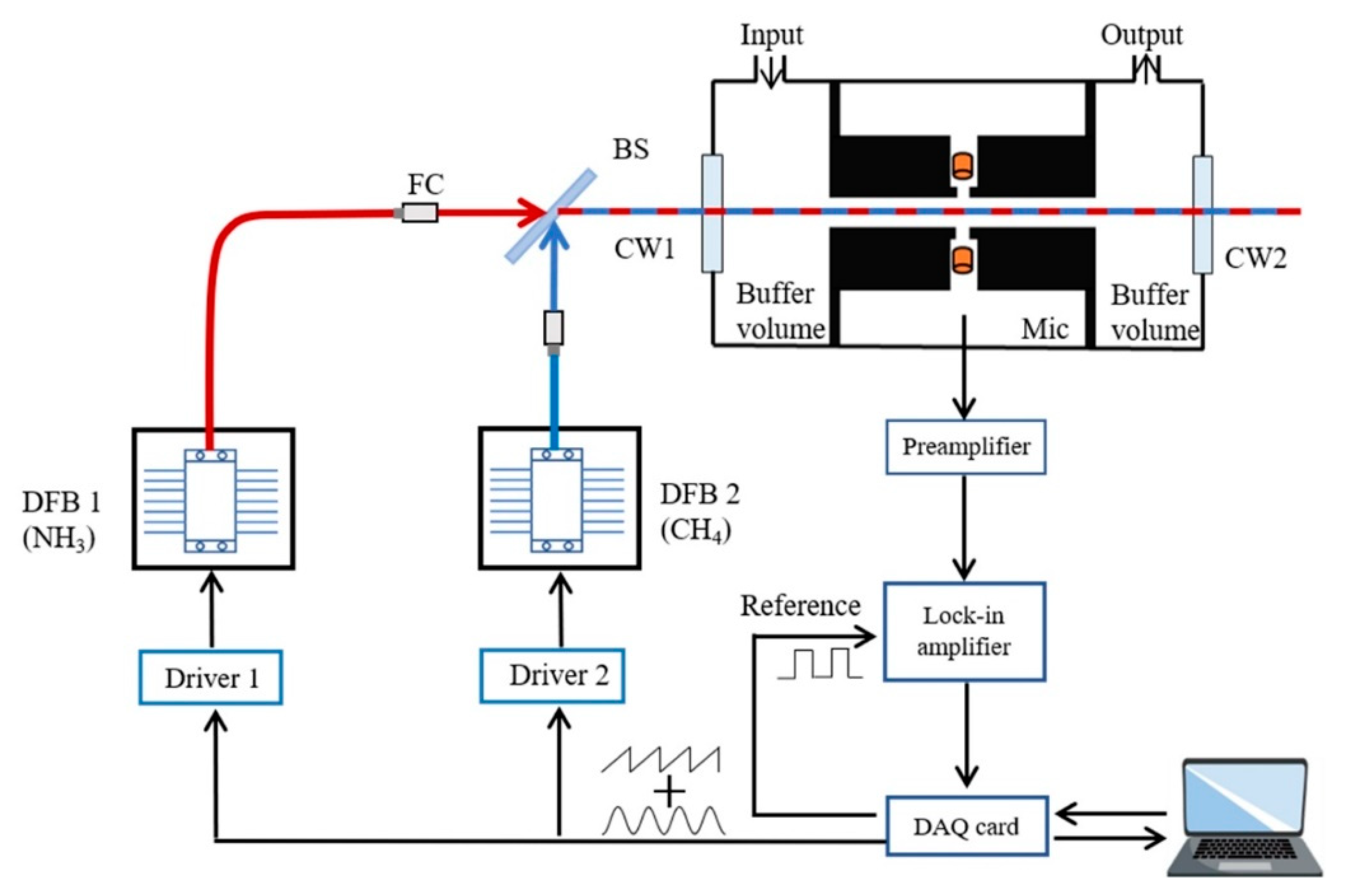
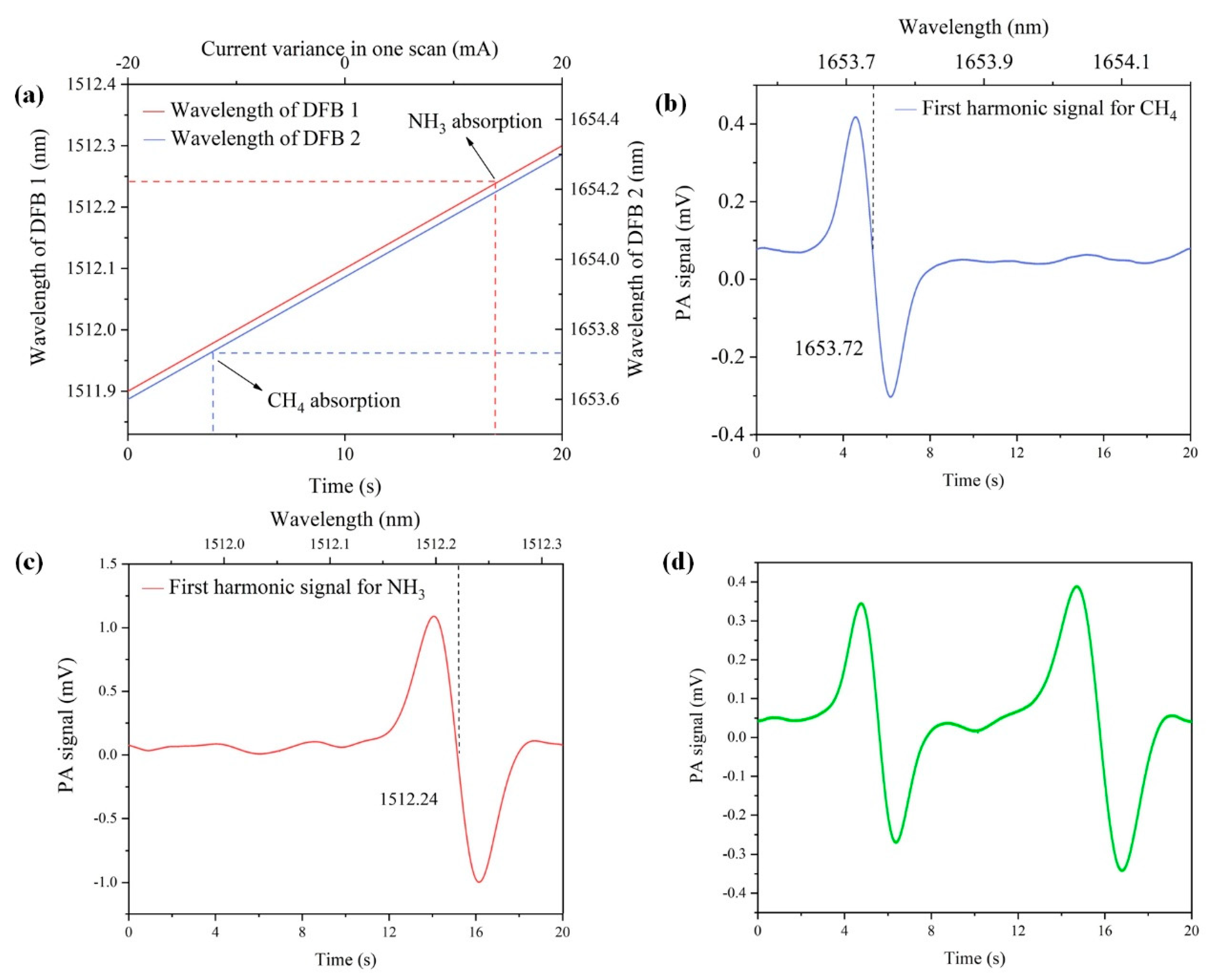
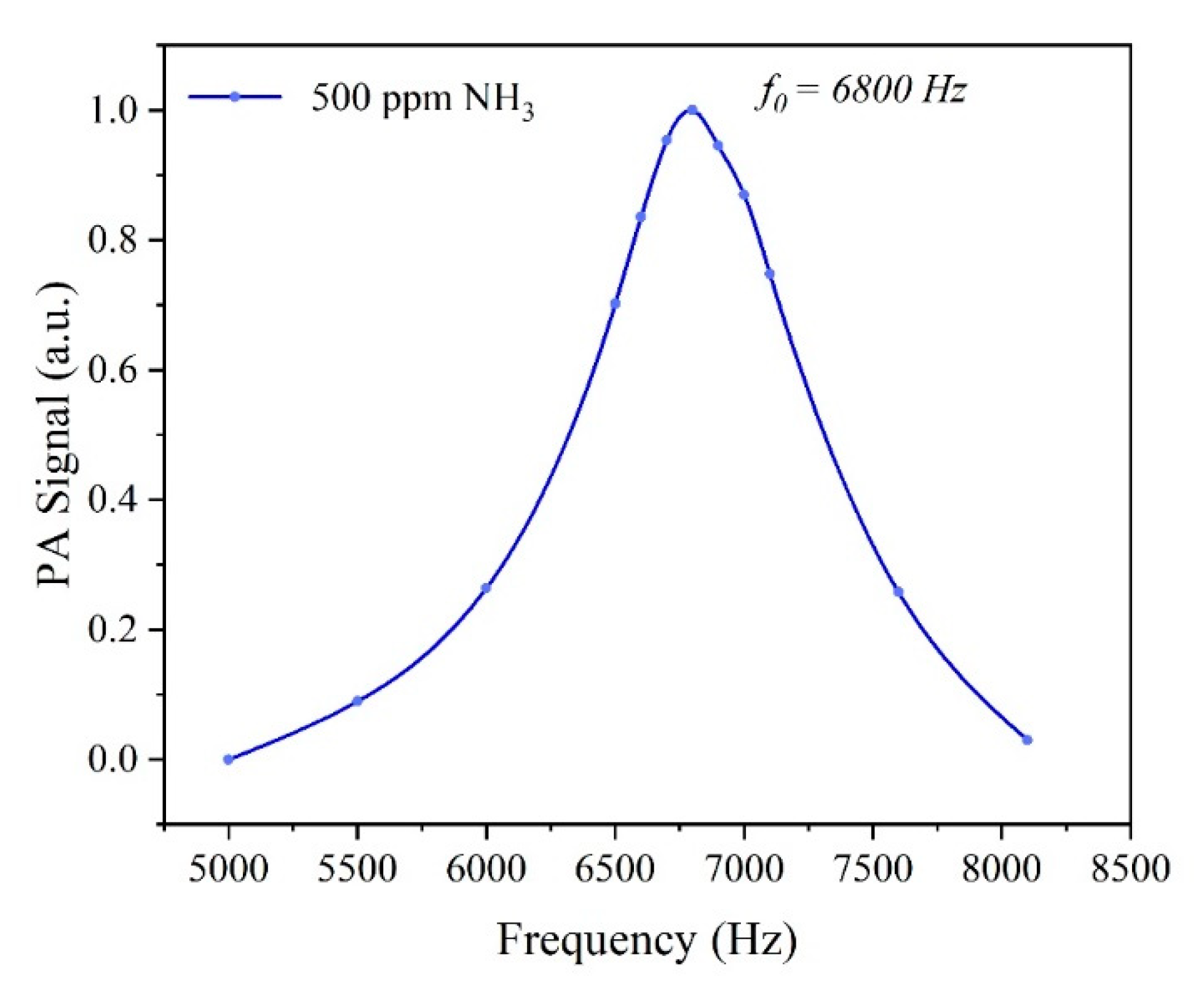
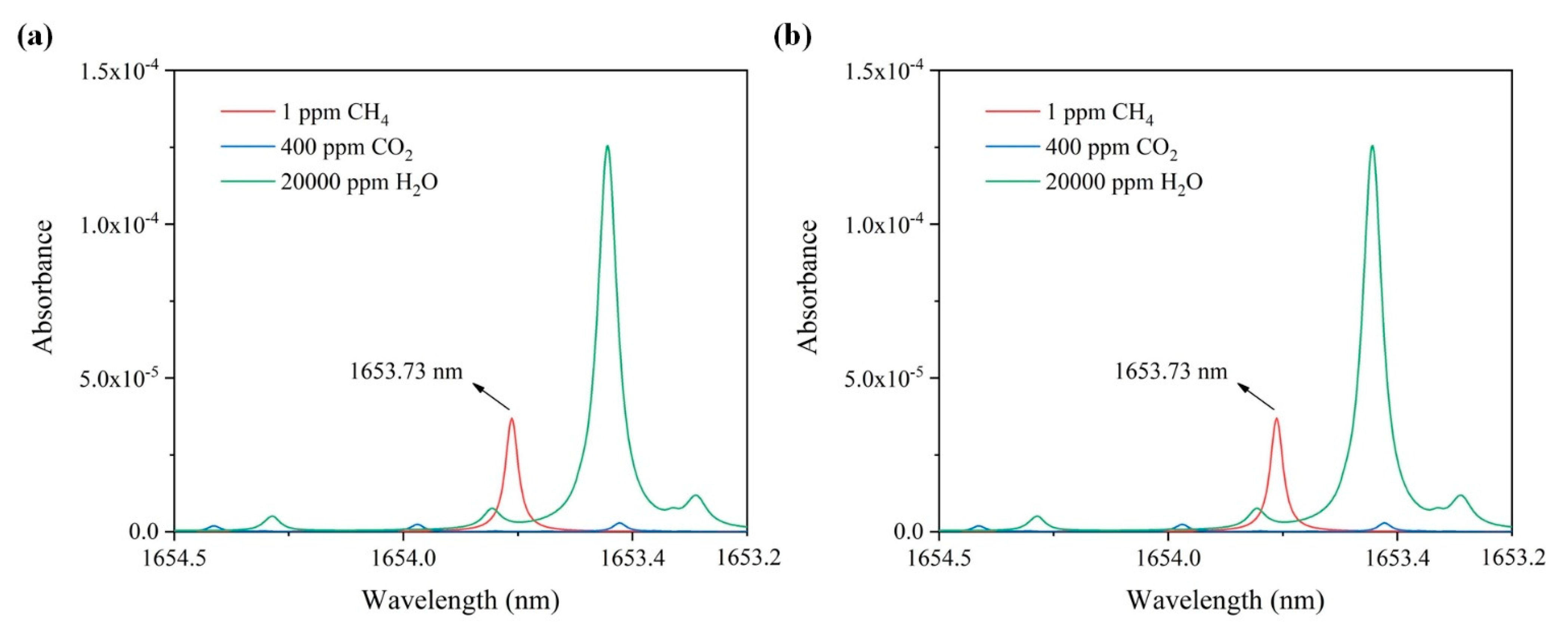

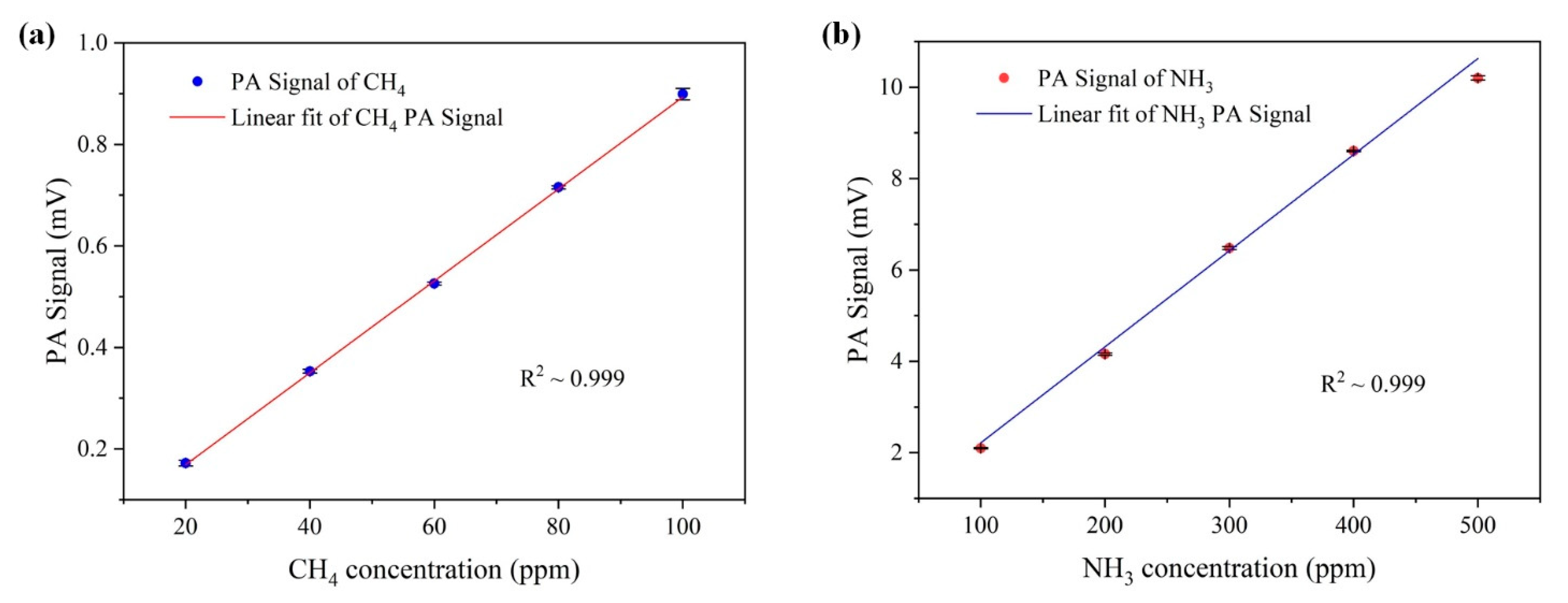
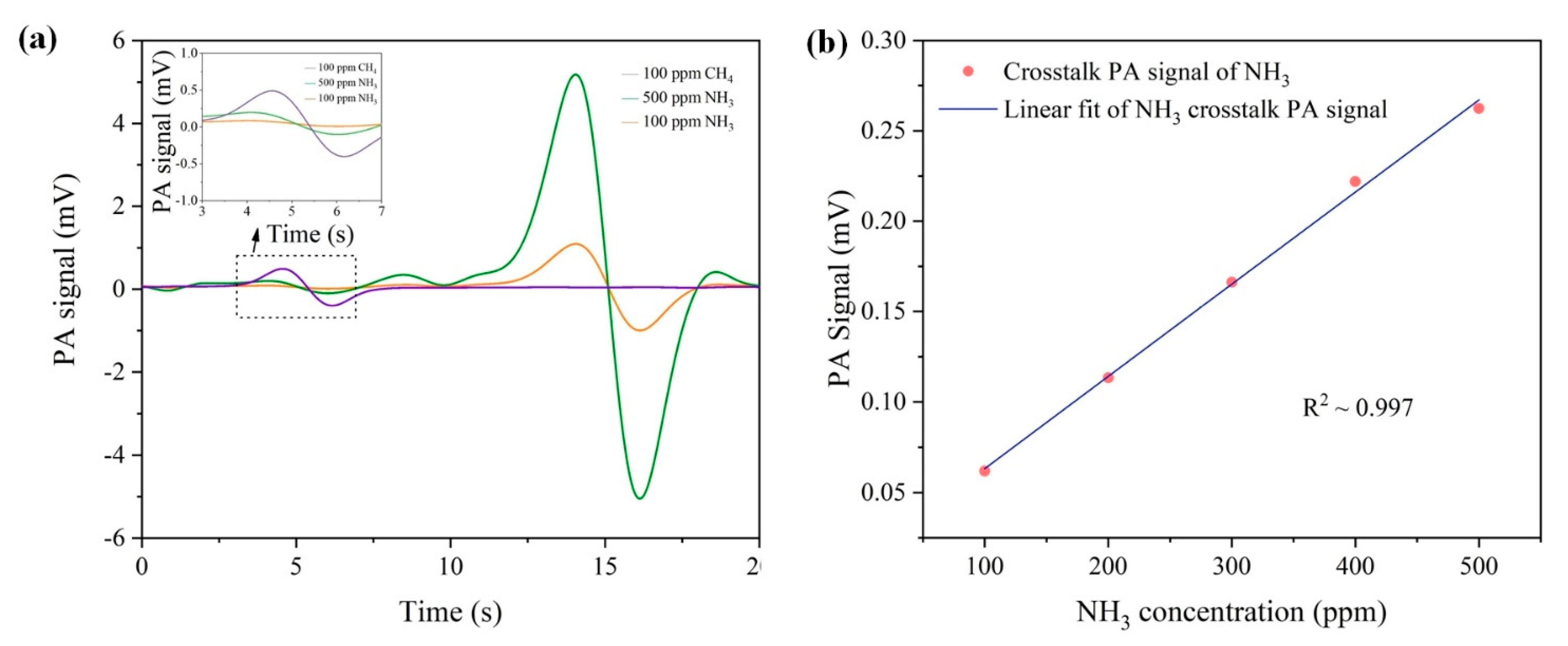
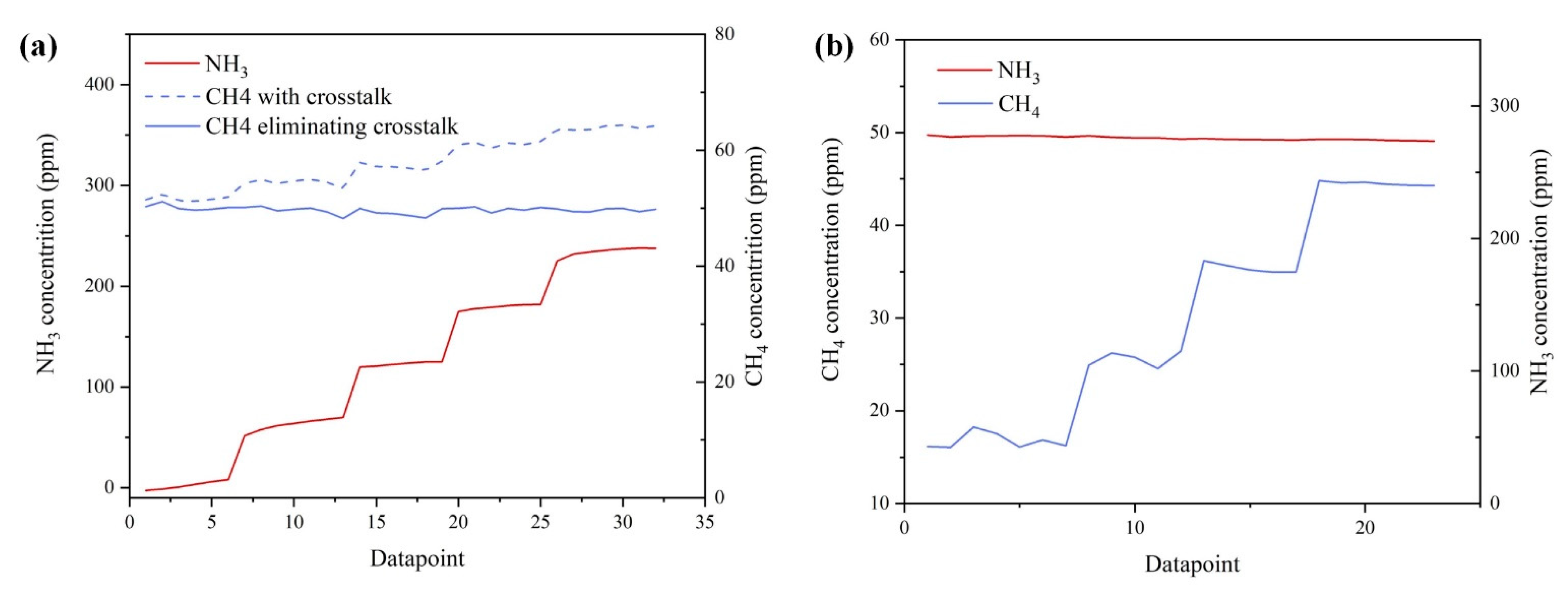
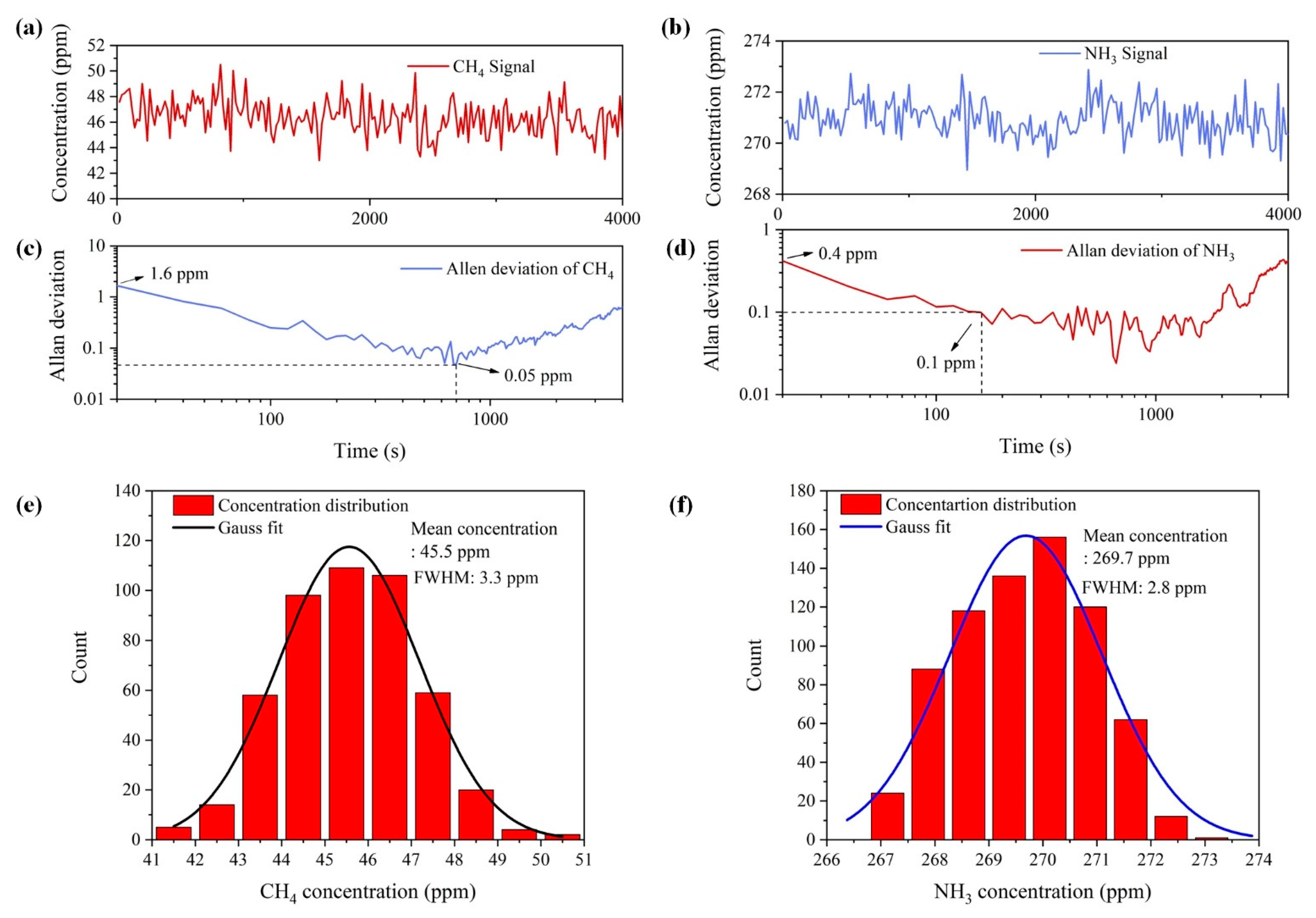
Publisher’s Note: MDPI stays neutral with regard to jurisdictional claims in published maps and institutional affiliations. |
© 2021 by the authors. Licensee MDPI, Basel, Switzerland. This article is an open access article distributed under the terms and conditions of the Creative Commons Attribution (CC BY) license (https://creativecommons.org/licenses/by/4.0/).
Share and Cite
Jiang, Y.; Zhang, T.; Wang, G.; He, S. A Dual-Gas Sensor Using Photoacoustic Spectroscopy Based on a Single Acoustic Resonator. Appl. Sci. 2021, 11, 5224. https://doi.org/10.3390/app11115224
Jiang Y, Zhang T, Wang G, He S. A Dual-Gas Sensor Using Photoacoustic Spectroscopy Based on a Single Acoustic Resonator. Applied Sciences. 2021; 11(11):5224. https://doi.org/10.3390/app11115224
Chicago/Turabian StyleJiang, Yiming, Tie Zhang, Gaoxuan Wang, and Sailing He. 2021. "A Dual-Gas Sensor Using Photoacoustic Spectroscopy Based on a Single Acoustic Resonator" Applied Sciences 11, no. 11: 5224. https://doi.org/10.3390/app11115224
APA StyleJiang, Y., Zhang, T., Wang, G., & He, S. (2021). A Dual-Gas Sensor Using Photoacoustic Spectroscopy Based on a Single Acoustic Resonator. Applied Sciences, 11(11), 5224. https://doi.org/10.3390/app11115224






